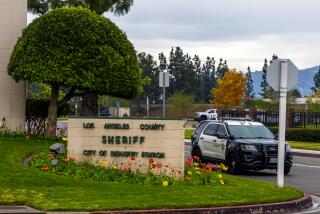Sheriff urged to staff cars with 2 deputies
- Share via
Los Angeles County Sheriff’s Deputy David Rodriguez peered suspiciously at half a dozen suspected gang members loitering at Compton’s Kelly Park. He thought they probably had drugs or weapons.
He slowed his patrol car to a crawl on Pauline Street but drove past the park. Like most deputies in Compton, Rodriguez works alone. And he learned early on that there are situations to avoid without a partner.
“You have to be a little more selective. Your main concern is to get home to your family,” Rodriguez said during a night patrol shift earlier this month. “If I had a partner, we’d talk to them, do a quick pat-down search, run them to see if they had warrants.”
Unlike the Los Angeles Police Department, which assigns two officers to more than 95% of its cars, the Sheriff’s Department has most of its deputies patrol by themselves, even in such high-crime areas as Compton. Cities that pay for sheriff’s services prefer to put more patrol cars on the streets, and that means having just one deputy per car, department executives said.
Compton’s mayor and the union that represents Los Angeles sheriff’s deputies have recently suggested that the department would do a better job if it assigned two deputies per car. In 2005, the Assn. for Los Angeles Deputy Sheriffs sponsored legislation that would have allocated state money to study the efficiency issue. The measure failed.
In the last 20 years, four sheriff’s deputies have been killed while working patrol assignments, three of them alone.
“One-man cars are less productive, less likely to confront people,” said Floyd Hayhurst, vice president of the deputies union. “Proactive law enforcement, not high visibility, reduces crime.”
Sheriff Lee Baca said he believes that one-deputy patrol cars are effective, in part because the visibility of additional cars on the streets discourages crime.
“When you have more radio cars out there, there’s a high belief they won’t get away,” Baca said.
Baca is familiar with the pros and cons of working alone. As a deputy, he patrolled East Los Angeles in the 1960s by himself. Deputies are trained not to handle potentially volatile calls alone; instead, they call for backup to arrive before acting.
According to a department analysis of deputies killed in action in the last 150 years, 27 deputies were killed while working with other deputies, 10 were killed by themselves and 33 were killed in transportation-related incidents. The numbers are a sign that the job is dangerous in any situation, the sheriff said.
“My deputies understand they’re going to work one-person cars. They’re courageous to accept those conditions, just as I was when I was a deputy,” Baca said.
The sheriff declined to say whether he would change to two-deputy cars if money were not a factor. “I don’t have a blank check,” he said.
Capt. Edward Rogner, who supervises the department’s contracts -- worth $206 million -- to police 40 Los Angeles County cities, said most cities can’t afford to pay for two deputies per car.
“Two-deputy cars are twice as expensive,” Rogner said. “For most cities, the public safety budget is a large item, and they really don’t have the additional resources.”
Compton Mayor Eric J. Perrodin said he thinks the city made a mistake in 2000 by disbanding its police force and contracting with the Sheriff’s Department. A former Compton police officer himself, Perrodin said deputies working alone can’t be as proactive.
“When I was working, that was a big issue for me. If my guys had to go out in one-person cars, especially at night, that was unacceptable,” said Perrodin, who is now a deputy district attorney. “The sheriff should tell the contract cities, ‘You’re going to have to pay for two-man units.’ If they did that, they wouldn’t have as many contract cities.”
Compton paid the Sheriff’s Department $13 million to police the city this fiscal year. It would cost as much as $26 million if the city were to insist that two deputies be assigned to each car, Rogner said.
“Basically, they could either double their current cost, or they could put two-man cars out and have half as many cars on the streets,” Rogner said. “In my opinion, neither option is feasible.”
Many large police departments nationwide, including the LAPD, assign two officers to patrol cars. LAPD Cmdr. Kirk Albanese said the department believes that two-officer cars are more efficient because they can handle most calls without having to wait for backup.
“If I’m a citizen in the city of Los Angeles, I would like the officers providing service for me to be proactive. I wouldn’t want an officer to shy away from a wanted parolee in a park where families are supposed to be because he’s alone and intimidated,” Albanese said. “There’s a level of confidence that goes along with having a partner officer standing next to you.”
Deputy Rodriguez, patrolling the streets of Compton last week, acted assertively throughout his shift. He spent the bulk of the night driving through narrow alleys looking for suspicious activity. In the first few hours, he searched for suspects in a purse snatching and in a drive-by shooting that injured two women and for a gang member who had barricaded himself in a backyard. Throughout the night, the buzz of a Sheriff’s Department helicopter could be heard overhead.
About 11 p.m. he was sent on a domestic violence call. Because those calls can prove dangerous, deputies are trained not to handle them alone. Rodriguez waited about two minutes for two other one-deputy cars to arrive, and the three deputies went to the home together. The woman was not injured, but it bothered him to have to wait for the others to arrive.
“You don’t want to handle a call like that alone. But at the same time, I don’t know if she’s being killed while I’m waiting,” he said. Sheriff’s Capt. William M. Ryan, who supervises the Compton station, said he would prefer two-person teams, but the financial reality is that won’t happen. Deputies do a good job of working as teams and responding quickly when a colleague needs help, he said.
“It’s always better on the law enforcement side if we have more people there, as opposed to a one-on-one scenario,” Ryan said.
Rodriguez said he understands the contention that flooding the streets with one-deputy cars makes residents feel safe. But he’s concerned that deputies are being placed at risk.
“Gang members, they look to see if you have a partner. They test you more if you don’t,” he said. “It’s really sad. In a city like this, you should have a partner.”
More to Read
Sign up for Essential California
The most important California stories and recommendations in your inbox every morning.
You may occasionally receive promotional content from the Los Angeles Times.














